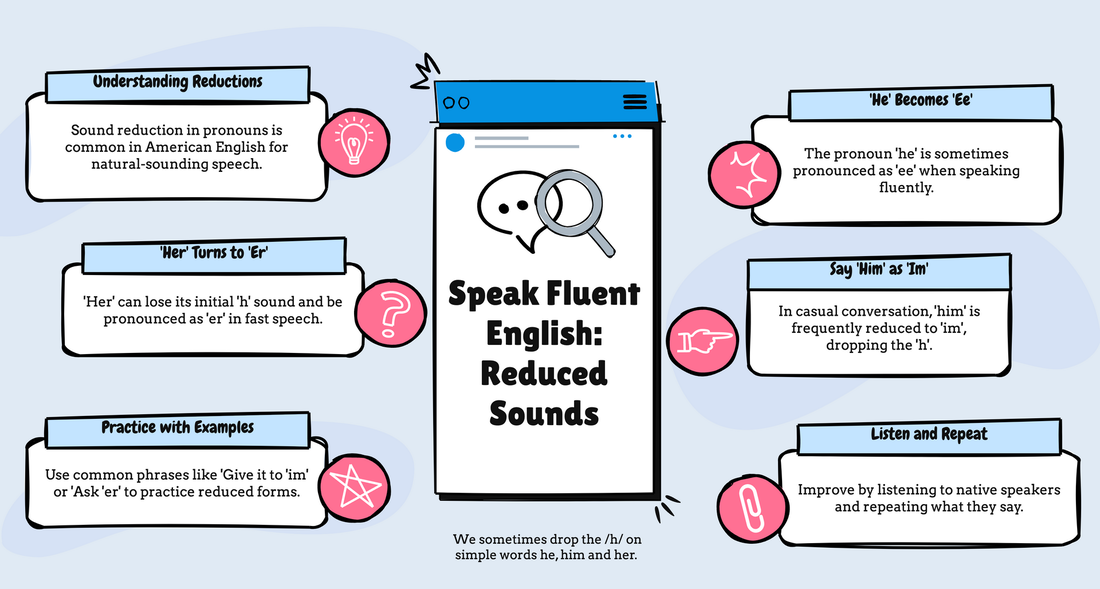|
Americans frequently simplify or reduce sounds in words in running speech. When pronouns beginning with “h” are in the middle and ends of phrases, the “h” is sometimes left off, as the pronouns are not stressed. For example, “Is he busy?” sounds more like “Izzy busy?” Try the following phrases, using a silent “h” on the words he, her and him.
Want more like this? Check out our REAL TALK online course!
0 Comments
At the sentence level, we stress one word (or syllable of a word) for each thought group. The typical pattern is to stress the last content word (noun, verb, or adjective) in the thought group. We raise our pitch and lengthen the vowel for the stressed word or syllable. Listen to these examples:
Notice that the overall pitch pattern for each thought group is to rise to the stressed word, then fall off at the end. When the last word of the thought group is stressed, it rises and falls on the single word, to indicate stress and the end of the thought. For example:
This standard stress pattern for a declarative sentence (rise in pitch to the most important word, then fall off) will vary when something needs extra emphasis. Examples might be to change from the standard meaning, to clarify, or for other special emphasis. Listen the sentences below. The words are the same, but the meaning changes when the stressed word changes.
An important step in being understood and sounding more American is learning to use American intonation. Intonation is the music of speech, the stress patterns or rhythms, the pitch changes, and the vocal tone. Intonation is complex, but there are some simple rules that you can learn which will help you understand and use correct American intonation. Word-Level Intonation For words with more than one syllable, we have an intonation pattern within the word. One syllable will have the main stress. This syllable will have a vowel sound which is held longer, has a higher pitch, and a clear vowel tone. Listen to the examples below. Can you hear which syllable has the stress?
Stress is marked with a small diacritic (a line similar to an apostrophe) before the stressed syllable. For example, on the word together, the stress falls on the second syllable "ge." It is easiest to listen to the word and repeat, following the stress pattern that you hear. For access to thousands of recordings of common words, technical and business words, and words sorted by sound and stress pattern, consider a subscription to our full online practice site. One final note on word stress - you are most likely using it correctly for most words. Error patterns are most likely to occur on words that you learned through reading rather than listening, as well as words that have a different stress pattern in the dialect of English that you first learned. For example, many dialects of English including Indian English and English spoken in many parts of Africa and Europe are influenced by British English, which has some differences from American English. For example, British English will stress the first syllable of French loan words, such as ballet and cafe; whereas American English will stress the second syllable, ballet and cafe.
Some languages have consistent stress patterns on words. For example, in Spanish, the last syllable is always stressed, unless the word ends with an s, n, or vowel, in which case the stress in on the second-to-last syllable. If your native language typically stresses the first syllable of a word, you may be likely to have errors on American English words that have syllable stress on the second or third syllables. You can find words sorted by syllable stress for your practice on our full site. When we speak English fluently, we often link between words. There are many types of linking. We addressed consonant to consonant linking here. Now we will turn to consonant to vowel linking.
Listen to the phrases below. First they are pronounced separately, then linked. Practice running the words together for a more natural, American-sounding pronunciation. Special note: when the sound “t” is linked to a vowel, it becomes a “d” sound. So “it is” sounds more like “ih diz.”
For more practice recordings, consider purchasing a subscription to our full online practice site.
When we speak English fluently, we often link between words. There are many types of linking. We will address consonant to consonant linking first. When the consonant sound at the end of a word is the same sound that starts the next word, we pronounce the consonant only once if it is a continuant sound. Continuants can be held, like s can be held out: sssssssss. Stopped sounds cannot be held, for example p cannot be drawn out to ppppp. Continuant consonants include f, v, s, z, th, sh, m, n, l and r.
These are not run together as one word so much as there is not a distinct stop to the ending consonant and start of the beginning consonant. When the ending consonant is a stopped consonant, we also link to the next consonant, but instead of continuing the sound into the next sound, we stop the consonant and don’t release the air. So when we say the word “stop” by itself, the p has a puff of air following it. When we say the phrase “stop that,” we stop our p sound but don’t release the puff of air. You can listen to the recordings of the examples to hear these phrases unlinked and linked. Stopped consonants include: p, b, t, d, k, g
For more practice recordings, consider purchasing a subscription to our full online practice site.
|
Categories
All
Archives
March 2024
Have Questions?
Get A Free Consultation We offer a free 30-minute phone consultation. Schedule yours now. |




 RSS Feed
RSS Feed

